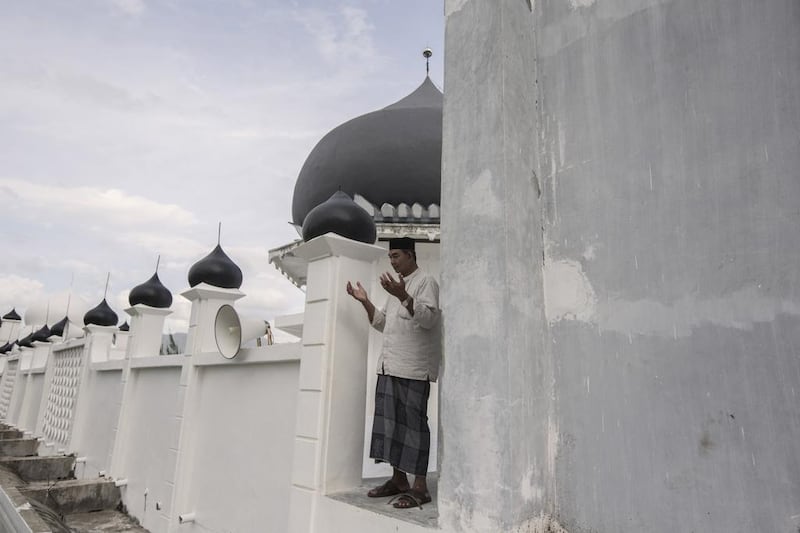“I keep on praying God to reunite with my dead children in dream, one day. So far, it never happened.” More than an hour into our interview, 44-year-old Armansiah Nyong is on the verge of tears. His new family, wife and two young kids, listening respectfully without saying a word, immediately sense the seriousness of the moment. The silence outside their new house is broken only by gusts of wind. He quickly regains his composure. “The tsunami will always be in my mind” he adds, in a sort of whisper. “At least once a month, I have nightmares of waves submerging me.”
At 7.59am on December 26, 2004, a 9.1-magnitude earthquake, whose epicentre was located 160km off the west coast of Sumatra, triggered the most powerful tsunami ever recorded. The quake unleashed a series of deadly waves up to 30 metres high that devastated the shores of 15 countries along the Indian Ocean, killing an estimated 280,000 people and displacing more than 1.6 million. With 80 per cent of the deaths, the Indonesian province of Aceh was the hardest hit. Here, 800 kilometres of coastline were destroyed, killing entire families and wiping out thousands of villages in a matter of seconds. Just like many others in this city on the western tip of Sumatra, Nyong is a survivor. He has faced death and his account of the events of that day are offered up in chilling detail and accuracy.
It was a Sunday morning and Nyong was serving as a rescue coastguard on the beach of Ulee Lheue, a Banda Aceh coastal neighbourhood that would later be dubbed “the ground zero” of the tsunami for the total destruction it experienced. The day was sunny and the beach was already packed with people walking and exercising. With his house only 200 metres away from the beach, Nyong had briefly gone home to check on his pregnant wife, leaving his two children, who were 2 and 6, with a friend. A few minutes before 8am, a powerful earthquake struck the city.
“It was very strong, my wife and I had to lie on the ground,” he remembers. “When it ended, there were a lot of cracks on the house walls.” Alarmed, Nyong went back to the beach, but was unable to find his children. He noticed that the ocean water had receded for more than one kilometre, leaving shoals of dying fish on a stretch of sand as wide as the eye could see. “People were running into the dry ocean to collect the fish, hurrying others to join,” Nyong continues, the tone of his voice almost anticipating the catastrophe. “I didn’t go. It looked weird to me, as if something bad was about to happen.”
A few minutes later, Nyong spotted a gigantic body of white foam on the horizon. The water was approaching the coastline at 800 kilometres per hour, followed by several deafening booms. When he realised he had to run away, it was too late. Nyong was knocked down by a huge mass of water while still close to the coastline. The second wave completely submerged him. When the third and biggest one hit Ulee Lheue, the high fronds of coconut palms were the only visible things. A strong man, Nyong managed to swim on top of the wave and grab an empty plastic tank to float. The scene around him was apocalyptic: the city had turned into sea, its blackened waters carrying any kind of debris, from cars to pieces of roofs and corpses. The water was rushing towards the town centre, destroying everything on its way. “At a certain point I bumped into a woman who was being carried by the stream,” he continues, gesturing heavily as if he was still inside the water. “I tried to hold her head under my arm, but the flow was so strong it swallowed her.”
Desperate to survive, Nyong managed to cling to the roof of a house. While he was trying to climb on it, he was hit in the back by a big piece of wood and almost fainted. On the verge of drowning, he managed to reach and grab a huge piece of wood with his remaining strength. The log was big and heavy enough to destroy everything on its path and Nyong rode on it for what seemed like an age. When the water finally started receding towards the sea, he ended up stranded four kilometres inland in what is now a big downtown park. “After I regained consciousness, I saw total mayhem,” he tells me. “There were dead bodies all around. People were breaking into shops, desperate for food and water.” Nyong was almost completely naked, his skin blackened. A few hours later, he was finally rescued and brought to a makeshift displaced camp, set up in the offices of the local Indonesian TV station.
It was only the following day that he was able to fully grasp the magnitude of the disaster. Spurred by the initial earthquake, the three waves had completely flattened the coastal neighbourhoods of Banda Aceh, leaving the city with 90,000 dead and no electricity, running water, roads or telephone lines. Desperate to find his family, Nyong decided to go back to Ulee Lheue, climbing over rubbish, debris and bodies for two hours on his journey. When he finally arrived, he found that the place he had once called home had been completely destroyed, parts of it swallowed by the sea and transformed into a lagoon of sorts. Heartened by the countless stories of family reunifications following the tsunami, Nyong kept on scouring every displaced camp in town for two years. To this date, he still doesn’t know what happened to his wife and children. As for the rest of his relatives? “I lost so many I can’t even count them,” he says.
Nyong remarried in 2007. Today, he lives with his new wife and two children in a cream-coloured house on Jackie Chan Hill (formally known as the Indonesia-China Friendship Village), an anonymous, Chinese-donated relocation site on the outskirts of Banda Aceh, built on the foot of a hill. The area is mostly inhabited by those families whose original land had been swallowed up by the ocean or deemed too dangerous for habitation.
While it took four months to clean the dirt and the grease from his skin, the memories of his lost ones endure, but he refuses to feel sorry for himself. “I lost my family, but I also started a new chapter in life, even if it took a lot of strength.” Just like him, hundreds of thousands of survivors whose daily lives had been swept away by the tsunami found the inner strength to cope with its consequences and rebuild from nothing. Far from inspiring pity, their stories are ones of inspiration and hope.
Ten years after that infamous Boxing Day, Banda Aceh is very different from the post-tsunami ghost city whose scenes of utter destruction shocked the world. Thanks to one of the biggest ever international relief efforts and a massive US$7 billion (Dh25.71bn) in aid, the city was rebuilt in less than three years by hundreds of foreign and local NGOs, coordinated by the Indonesian Agency for the Rehabilitation and Reconstruction of Aceh (BRR). All over the region, BRR reconstructed 140,000 houses, 1,700 schools and almost 4,000 kms of road. The affected areas were turned into new residential complexes made of basic, identical matchbox houses, which allowed authorities to provide modest dwellings for more than 500,000 displaced in a relatively short period of time. New relocation sites were created for villages deemed too unsafe to be reoccupied, as well as for those people who didn’t have land titles before the tsunami or whose land had been inundated by the sea.
Today, a series of wide, neat boulevards punctuated with palm trees and flower beds link Banda Aceh’s bustling city centre with the coastline. What is left of Ulee Lheue and the old port area are now protected by a seawall, while other neighbourhoods have been shielded from the sea by rows of mangroves. In case of another tsunami, the wide boulevards and a series of clearly indicated escape routes are supposed to facilitate the evacuation of the coastal areas, together with a brand new early warning system and several escape buildings, made of large, high-ground terraces that can shelter thousands of people.
“I think we are better equipped now than before,” says Illiza Sa’aduddin Djamal, an elegantly dressed, middle-aged woman who has been the mayor of Banda Aceh since 2007. “The city landscape has been totally changed and is now one of the best in Indonesia.”
The psychological scars have been much more difficult to mend. Deeply religious Muslims, the Acehnese have rationalised the event by ascribing it to the will of God, interpreting it as a wake-up call or punishment sent to a supposedly sinful community. “Religion became the medicine in order to recover from our traumas,” explains 62-year-old Sulaiman Amin, the imam of Lampuuk, a small village on the outskirts of Banda Aceh whose mosque was the only building still standing after the tsunami. “You can imagine the power of God,” he says solemnly, looking with admiration at the whitewashed columns and black dome that withstood the rage of the water. Amin, who lost not only his wife and 18-year-old son, but also a small rice processing factory (for which he never received any compensation), was chosen as the new imam from the community three years after the tsunami. “I survived because of God’s will and I have to honour it,” he says with conviction.
The destruction caused by the tsunami was also instrumental in ending a bloody 29-year-long civil war, prompting the 2005 peace agreement between the Indonesian government and the separatist rebels of the Free Aceh Movement. Some, like 52-year-old Saifuddin Bantasyam, the director of the Centre for Peace and Conflict Resolution Studies at Syiah Kuala University, even define the tsunami as a blessing in disguise. “Despite all the deaths, the loss of property and the suffering of the survivors, the tsunami offered Aceh with the opportunity to rebuild its society through the peace agreement,” he says. “People now are more united than before.”
However, many are still deeply traumatised by the tsunami and run from their houses every time there’s a small tremor, a fairly common event in this highly seismic region. Others find it difficult to accept what happened to their loved ones. “In the first year after the tsunami I used to think: ‘Why did I survive? Wasn’t it better to go together with my sons?’ I still have these thoughts sometimes” confesses 49-year-old Yusnida, a melancholy woman from the area of Lampaseh. A few metres away from her reconstructed matchbox house lies the skeleton of what used to be a beautiful two-storey villa, decorated with white and green tiles. The woman thinks about the tsunami every time she looks at it. “I laid stranded there between the second and the third wave, before the stream finally brought me in the open sea,” she remembers. An oyster collector and the mother of three children, two of whom were killed by the waves, Yusnida spent almost 12 hours at sea before being rescued by fishermen. She was able to return to her reconstructed house two years after the tsunami, only to find the atmosphere of the village dramatically changed, with the thousands of victims replaced by newcomers. “They frequently ask questions about the tsunami, but nobody can understand what being a survivor feels like,” Yusnida says. Forever bonded by their tragic experiences, the survivors of Lampaseh often organise ceremonies for the end of Ramadan and the tsunami anniversaries. There, they eat and pray together, sharing the stories of their lost relatives. “I speak about my sons and listen to the others’ experiences,” she explains. “I feel relieved, it’s a big weight off my heart.”
All of Banda Aceh is dotted with memorials of the event, from the Tsunami Museum, whose structure dominates the downtown area, to plaques, stranded boats turned into tsunami monuments, poles marking the height reached by the water and mass graves. The biggest one, a barren, neatly mown lawn at the entrance of Ulee Lheue, houses the remains of 14,800 people. Nearby sit the ruins of what used to be the second-biggest hospital in town before it was destroyed.
Just behind is the headquarters of the Tsunami and Disaster Mitigation Research Centre, itself a bleak escape building, in whose garden sits the carcass of a police helicopter destroyed by the waves. Tasked with organising tsunami-preparedness educational programmes at school and community level, the Centre is understaffed and short of funds. Almost all its activities ceased in 2008, when donations ran out. According to its worried 28-year-old programme manager Ella Meilianda, the local government doesn’t seem interested in stepping in. “How will we prepare for future events?” she asks. “We have to transfer knowledge to the younger generations.”
The importance of remembrance came to light in Simeulue, a small island off the west coast of Aceh that experienced an earlier tsunami in 1907. There, local elders were able to transfer the knowledge of that event through oral traditions, and the people reacted to the unusual receding of the sea and quickly took shelter. As a result, the island lost only seven people out of a population of 78,000. In contrast, when Banda Aceh experienced a strong, double earthquake in April 2012, few people used the escape buildings or followed evacuation routes. Most of them tried to flee parallel to the coastline, causing huge traffic jams that could have resulted in another disaster, should another tsunami have been triggered. Moreover, the early warning system didn’t work as intended, causing more panic.
According to 40-year-old psychologist Yulia Direzkia, who conducted extensive research on the effects of the tsunami on the local population, the massive influx of foreign aid money and NGOs that took charge of most of the day-to-day reconstruction could be part of the problem. Although fundamental in tackling the urgent and unprecedented emergency, the lack of local participation in reconstruction and post-disaster management created a sort of moral hazard. “After the 2006 earthquake in Yogyakarta [a city on the Indonesian island of Java], people rebuilt their houses themselves,” Direzkia says. “As a result, they became more knowledgeable and resilient than us.”
The tsunami also brought some positive news. The reconstruction effort spurred an economic boom in a long-neglected and war-torn region, creating business and employment opportunities for many locals. Yessi Kemala Dewi, a plump, vigorous young woman of 37 from the village of Padang Seurahet, was one of those who benefited. As part of an economic empowerment programme run by a Swiss NGO, Dewi was given three sewing machines. Together with her two younger sisters, she set up a profitable business, which allowed the family to earn enough money to double the size of their house. Today, half of the living room is occupied by the family workshop and the three sisters receive orders for curtains, bed covers and marriage tents from several clients all around the west coast of Aceh. “For us the tsunami was a blessing, even if it came at a hefty price,” she says. “We were able to send all our children to school.”
That success wouldn’t have been possible without the strong bond the sisters developed during the tsunami. While they were trying to run away from the coastline, Dewi and her 31-year-old sister Fawzia were caught by the waves. A cabinet carried by the water hit Dewi from behind, trapping her leg. “I told Fawzia to go and save herself, but she didn’t want to leave me there,” she tells me. “When the second wave arrived, we were both carried by the stream to the roof of a nearby house.” The pair remained there until late afternoon, when the level of the water finally started to diminish. Fawzia got married and had her first baby two years ago; Dewi, whose husband and eldest daughter survived the tsunami, gave birth to a boy two years after the tsunami.
Today the region has returned to its formerly quiet, laid-back existence. The trip from Banda Aceh through the most affected areas along the west coast is now a journey through tropical hills and pristine beaches, occasionally interrupted by fishing villages. The omnipresence of the new matchbox houses are the only remaining clue to the magnitude of the tragedy. Here, the government initially proposed creating a two-kilometre buffer zone along low-lying coastal areas, but the plan was abandoned after the opposition of several coastal communities determined to preserve their traditional way of life and ancestral land. Abandoning the sea was out of the question, no matter the risks.
Most of the local fishermen returned to the ocean after a couple of years, renewing a contract that has defined Aceh’s living history. “The tsunami never changed my connection with the sea,” Nyong says. “I love diving and fishing and I miss living close to it.” Now a security guard in a government office, he is still a child of the sea and Ulee Lheue. “When I was a kid, I used to live so close to the water I could almost jump in it from my window,” he says. Unable to let the past go, he will soon visit Ulee Lheue again, this time bringing his 6-year-old son. “I will take him to where my house was and to the beach,” he says. “I want him to know what happened.”
Matteo Fagotto is a freelance journalist focusing on social and human rights issues and the co-founder of Tandem Reportages. His work has been published in Time, Newsweek, The Guardian, Die Zeit, the Toronto Star and Wired
[ thereview@thenational.ae ]





